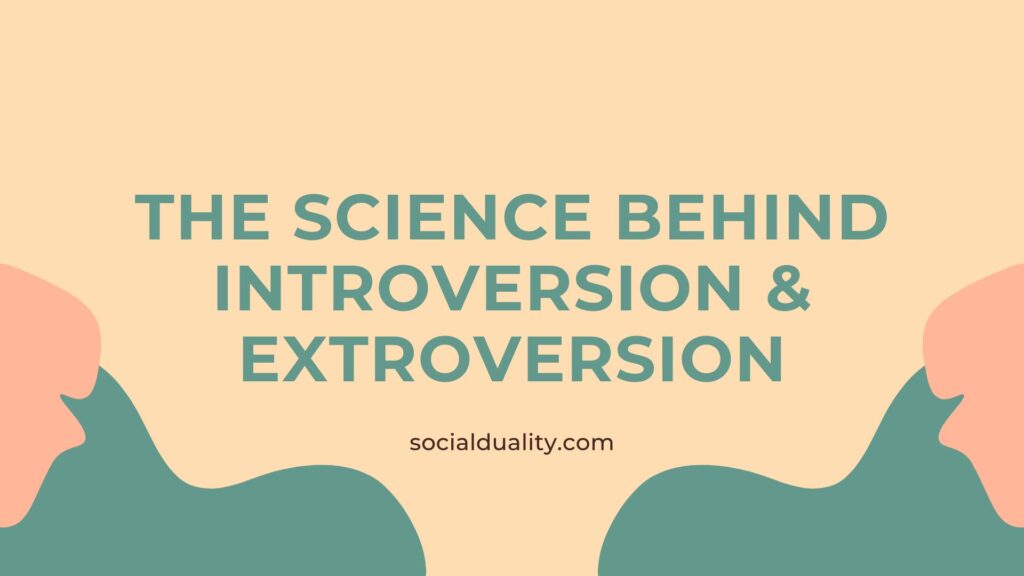Ever wondered why some people thrive in social situations, while others prefer solitude? The answer lies in the biochemical story of our brains. Introverts and extroverts have different brain chemistries and nervous system responses. Introverts tend to be more sensitive to dopamine, the brain’s reward chemical, leading them to seek quieter environments. On the flip side, extroverts crave social interaction to get their dopamine hit. This fascinating dichotomy is not just about preferences but rooted in our biology.
In this post, we’ll dive into the science of introversion and extroversion, drawing insights from experts like Marti Olsen Laney and Martin Picardi. Whether you’re an introvert, extrovert, or somewhere in between, you’ll find the story behind introversion and extroversion intriguing.
Key Takeaways
- Introverts are more sensitive to dopamine, leading them to prefer quieter environments.
- Extroverts seek social interactions to get their dopamine boost.
- Introverts have more gray matter, impacting their brain function and nervous system responses.
- Acetylcholine pathways in introverts enhance their ability to focus and think deeply.
- Common misconceptions about introverts and extroverts include the idea that one is superior to the other.
Dissecting Introversion: A Deep Dive into the Introvert Brain
Examining introversion reveals intriguing aspects of the introvert brain. Introverts tend to process stimuli more deeply, thanks to their sensitive nervous system. This heightened sensitivity often makes them more cautious in social settings.
Interestingly, introverts and extroverts exhibit distinct personality traits due to their varying dopamine levels. Introverts produce enough dopamine naturally, whereas extroverts seek external stimulation to boost theirs. Consequently, this difference affects how people interact with their surroundings.
Dr. Laney’s work highlights the introvert advantage, showing how introverts excel in tasks requiring focus and reflection. Manning’s studies underscore that personality tests, such as the extroversion introversion test, often reveal these deep-seated inclinations.
On the flip side, comments on AskScience suggest that these personality differences are more nuanced than once believed. Understanding the brain’s role in shaping these traits enriches our view of introversion & extroversion, making us appreciate each side’s unique strengths.
The Role of Dopamine in Introvert Sensitivity
Delving into how dopamine impacts introvert sensitivity reveals fascinating insights. Introverts experience increased sensitivity due to their nervous system‘s response to dopamine. This heightened response can make social situations overwhelming, as their brain already operates on optimal dopamine levels.
For introverts and extroverts, these differences are stark. Introverts often need less external stimulation, while extroverts crave more. Manning’s work suggests that personality tests confirm these variances, pointing to innate personality traits.
Comments on AskScience highlight that this isn’t just about dopamine but how it interacts with other chemicals. Laney, in her book, explains that managing this sensitivity can be an introvert advantage, helping them excel in focused tasks. For a deeper dive, check out this article, which expands on the nuanced interplay between brain function and personality.
The Unique Pathway of Acetylcholine in Introverts
Understanding the pathway of acetylcholine in introverts reveals its major influence on their behavior. This neurotransmitter promotes calm and focus, providing introverts with a sense of satisfaction from solitary activities. Introverts often find solace in quiet environments, where acetylcholine’s effects are more pronounced. Unlike extroverts, who thrive on dopamine-driven excitement, introverts’ brains are wired to enjoy deep thought and minimal stimulation. Manning’s studies highlight how these differences shape our social interactions and preferences.
People with introverted tendencies feel more at ease in controlled settings, making them adept at tasks requiring concentration. The introvert advantage is evident here, as introverts excel in roles demanding meticulous attention. Comments on AskScience often underscore how acetylcholine’s role contrasts sharply with dopamine’s, highlighting the unique strengths of each personality type. This intricate dance between neurotransmitters underscores the rich diversity in human behavior, spanning the spectrum of introversion and extroversion.
Why do Introverts Have More Gray Matter?
Curious why introverts possess more gray matter? The brain structure differences between introversion and extroversion offer intriguing insights. Studies indicate that introverts have increased gray matter volume in areas linked to thoughtful processing, such as the prefrontal cortex. This enhances their capacity for deep thinking and introspection.
Unlike extroverts, who thrive on external stimuli, introverts’ brains are wired to enjoy minimal stimulation and focused tasks. This structural distinction in the nervous system might explain why introverts excel in environments requiring concentration and reflection.
Research by Manning suggests that these brain differences also influence how introverts and extroverts process dopamine, the reward chemical. While extroverts seek social interactions for dopamine boosts, introverts derive satisfaction from solitary activities.
For those intrigued by the nuances of personality and brain function, Magical Daydream offers a deeper exploration into these fascinating differences.
Breaking Down Extroversion: Decoding the Extrovert Brain
Decoding the extrovert brain reveals a fascinating interplay of neurotransmitters and brain regions. Extroverts have a more reactive dopamine system, which fuels their craving for social interaction and excitement. This heightened sensitivity drives them to seek out stimulating environments, providing a constant dopamine rush.
Interestingly, the prefrontal cortex, associated with decision-making, shows different activation patterns in extroverts compared to their counterparts. This variation might explain their spontaneous and sociable nature. Manning’s research highlights that these brain differences contribute to distinct reward processing methods, with extroverts thriving on external validation.
For those interested in further scientific insights on this topic, the ScienceDirect article provides an in-depth exploration.
| Aspect | Extroverts | Introverts | Comments |
|---|---|---|---|
| Dopamine Sensitivity | High | Low | Influences social behavior |
| Prefrontal Cortex | Reactive | Less reactive | Affects decision-making |
| Social Interaction | Seeks and enjoys | Avoids or limits | Personality driven |
| Reward Processing | External validation | Internal satisfaction | Manning’s research |
| Nervous System | Stimulus-seeking | Stimulus-avoiding | AskScience findings |
How a Different Side of the Nervous System is Preferred by Extroverts
Different sides of the nervous system are preferred by those with extroversion. Extroverts’ preference for stimulation ties into their social behavior and personality. Manning’s research highlights how they seek external validation and enjoy social interactions.
Laney observes that extroverts thrive on high levels of external stimuli, often feeling energized by people and activities. This aligns with AskScience findings, which indicate extroverts’ tendency to pursue stimulus-seeking behaviors.
Comments and discussions often point out that extroverts’ reward processing differs significantly from introverts’. They are usually drawn to environments that offer constant engagement and excitement, contrasting with introversion.
The personality traits of extroverts lead them to be more outgoing and sociable, aligning with their biochemical makeup. This preference for a different side of the nervous system explains their inclination toward active, dynamic environments, making extroversion a fascinating topic for further exploration.
Extroverts and the Parasympathetic Side: A Connection
The connection between extroverts and the parasympathetic side unveils intriguing dynamics. Extroverts often show a unique relationship with their parasympathetic system, which is responsible for rest and digestion. This aspect of their personality might seem counterintuitive, given their energetic nature. However, Manning suggests that their ability to thrive in high-stimulus environments could indicate an efficient parasympathetic response, allowing rapid recovery.
In AskScience forums, comments often highlight how these individuals manage stress differently. Unlike those with introversion, extroverts might find solace in social settings, which could activate their parasympathetic side. Laney’s research supports this, showing that their social engagements might serve as a form of relaxation.
Thus, understanding extroversion involves acknowledging this complex interplay. It offers a refreshing perspective on how different sides of the nervous system can shape our interactions and behaviors. This area remains ripe for further exploration.
The Advantage of Extroversion: Uncovering the Reality
Reality reveals that extroversion often brings several advantages. One key benefit is the ease with which extroverts build and maintain social connections. This knack for networking often translates into better opportunities in both personal and professional settings.
Moreover, their social nature typically fosters a higher level of engagement and enthusiasm in group activities. This can lead to increased visibility and recognition among peers.
Here are some tangible benefits:
- Enhanced Communication Skills: Regular social interaction sharpens their ability to articulate thoughts clearly.
- Broader Network: Extroverts usually have a larger circle of acquaintances.
- Greater Job Opportunities: Networking can open doors to career advancements.
- Improved Mental Health: Socializing can alleviate feelings of loneliness and stress.
- Leadership Potential: Their confidence in social settings often positions them as natural leaders.
Despite these advantages, it’s essential to recognize the value of both introversion and extroversion in creating a balanced society.
The Biochemical Story: How Introversion and Extroversion Affect Personality
The biochemical influence of introversion & extroversion on personality goes beyond social preferences. Different sides of the brain light up depending on whether someone is more introverted or extroverted. Laney notes that introverts experience higher activation in the prefrontal cortex, making them more reflective. Extroverts, on the other hand, get a stronger dopamine response, pushing them towards more stimulating activities.
In AskScience, researchers discuss how these chemical differences shape behaviors and interactions. For example, introverts might prefer quieter, low-key environments, while extroverts thrive in dynamic, social settings. These biochemical patterns impact everything from decision-making processes to stress responses.
People often wonder if one personality type is better than the other. The reality is, both have unique strengths and challenges. Comments from psychologists emphasize that understanding these differences can foster empathy and better communication.
Ultimately, embracing the diversity of personality types enriches our communities and interactions.
3 Misconceptions About Introversion and Extroversion Debunked
Debunking misconceptions about Introversion & Extroversion can clarify many common misunderstandings. One major myth is that introverted people are shy and extroverted ones are outgoing. However, introversion and extroversion refer to energy sources rather than social behaviors.
Another fallacy is believing that one side of the spectrum, such as introversion, is better suited for creative tasks. In reality, both personality types have their unique creative processes and contributions.
Lastly, comments often suggest that introverts dislike social interaction and extroverts love it. The truth is that both types enjoy socializing; they just have different preferences and limits.
Consider these key points to understand these misconceptions better:
- Introversion doesn’t mean shyness.
- Both types can be equally creative.
- Social interaction preferences vary but aren’t exclusive.
Understanding these nuances helps foster better empathy and communication.
Conclusion
Understanding the science behind introversion and extroversion gives us a clearer picture of why people behave the way they do. Introverts and extroverts aren’t just defined by their social preferences; their brains are wired differently. These differences in brain chemistry and structure can affect everything from how we process information to how we handle social situations.
Knowledge of these differences can improve our relationships and work environments. Whether you’re an introvert, extrovert, or somewhere in between, it’s vital to recognize and appreciate these variances. This understanding can lead to more empathy and better communication. Isn’t it fascinating how our brains shape who we are?
FAQ
What is the main difference between introverts and extroverts?
Introverts tend to feel more comfortable in quieter environments and often need alone time to recharge. Extroverts, on the other hand, thrive in social settings and get energized from being around others. This fundamental difference is linked to how their brains handle stimuli and dopamine.
How does dopamine affect introverts and extroverts differently?
Dopamine is a neurotransmitter associated with pleasure and reward. Introverts have a more sensitive dopamine system, which means they can feel overstimulated more easily. This makes them prefer calm and less stimulating environments. Extroverts have a less sensitive dopamine system, so they seek more external stimulation to feel the same level of reward.
Why do introverts have more gray matter in their brains?
Introverts generally have more gray matter in the prefrontal cortex, the area associated with decision-making and abstract thought. This could explain why they often prefer deeper thinking and introspection. The extra gray matter allows for more complex processing and reflective thinking.
How do extroverts differ in their nervous system preferences?
Extroverts rely more on the parasympathetic nervous system, which helps them stay calm and relaxed even in stimulating environments. This preference allows them to handle social interactions and busy settings with ease, making them more outgoing and sociable.
What are some common misconceptions about introversion and extroversion?
One common misconception is that introverts are shy or antisocial. This isn’t true; introverts simply need time alone to recharge. Another myth is that extroverts are always outgoing and loud. Extroverts can also enjoy quiet activities but gain energy from social interaction. Lastly, it’s false to think people are strictly one or the other—most of us fall somewhere on a spectrum.


